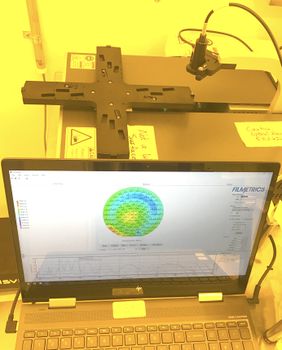Difference between revisions of "Optical Film Thickness & Wafer-Mapping (Filmetrics F50)"
(pasted F20 text, update for F50) |
(→Equipment Specifications: added photo, minor updates) |
||
| Line 1: | Line 1: | ||
{{tool|{{PAGENAME}} |
{{tool|{{PAGENAME}} |
||
| − | |picture= |
+ | |picture=FIlmetrics_F50_Photo_v1.jpg |
|type = Inspection, Test and Characterization |
|type = Inspection, Test and Characterization |
||
|super= Ning Cao |
|super= Ning Cao |
||
| − | |phone= |
||
|location=Bay 6 |
|location=Bay 6 |
||
| − | |email= |
||
|description = Thin-Film Reflectometry |
|description = Thin-Film Reflectometry |
||
|manufacturer = [http://www.filmetrics.com/ Filmetrics] |
|manufacturer = [http://www.filmetrics.com/ Filmetrics] |
||
| − | |model = |
+ | |model = F50 |
|materials = |
|materials = |
||
}} |
}} |
||
= About = |
= About = |
||
This tool is for thickness and optical property measurements of films on substrates, including mapping of thin-films on full wafers. |
This tool is for thickness and optical property measurements of films on substrates, including mapping of thin-films on full wafers. |
||
| − | The technique used is white light reflection. Data is taken with normal incidence reflection of white light (190 nm – 1700 nm) from the surface using a Deuterium (UV) and Halogen (Vis-nIR) lamps. |
+ | The technique used is white light reflection. Data is taken with normal incidence reflection of white light (190 nm – 1700 nm) from the surface using a Deuterium (UV) and Halogen (Vis-nIR) lamps. |
| + | |||
| + | The motorized stage automatically acquires optical reflection spectra at programmed points across the wafer. At each point, the reflection spectrum is baselines, and the reflection data is modeled at each point, and finally the optical parameters (thickness/refractive index/absorption) are adjusted to give a best least-squared fit to the data. The accuracy of the technique will depend on the thickness of the film and the optical models used for the fitting of the data. For a more complete description go to [http://www.filmetrics.com/ Filmetrics]. |
||
=Equipment Specifications= |
=Equipment Specifications= |
||
*190-1700 nm reflection spectrum |
*190-1700 nm reflection spectrum |
||
| + | *Deuterium (UV) and Halogen (Vis-nIR) light sources |
||
| − | *10 Å to 150 µm thickness, n, and k measurements |
+ | *10 Å to 150 µm thickness, ''n'', and ''k'' measurements |
| − | *Accepts wafers up to 150mm for motorized mapping. |
||
| + | *Motorized mapping on wafers up to 150mm. |
||
*Small substrates also possible, ≥ 2-3mm |
*Small substrates also possible, ≥ 2-3mm |
||
| − | *Data can be |
+ | *Spectrum Data can be exported |
*Can model up to three layers with accuracy |
*Can model up to three layers with accuracy |
||
| + | |||
| + | =Operatin Procedures= |
||
| + | ''To be added'' |
||
Revision as of 15:10, 25 April 2019
|
About
This tool is for thickness and optical property measurements of films on substrates, including mapping of thin-films on full wafers. The technique used is white light reflection. Data is taken with normal incidence reflection of white light (190 nm – 1700 nm) from the surface using a Deuterium (UV) and Halogen (Vis-nIR) lamps.
The motorized stage automatically acquires optical reflection spectra at programmed points across the wafer. At each point, the reflection spectrum is baselines, and the reflection data is modeled at each point, and finally the optical parameters (thickness/refractive index/absorption) are adjusted to give a best least-squared fit to the data. The accuracy of the technique will depend on the thickness of the film and the optical models used for the fitting of the data. For a more complete description go to Filmetrics.
Equipment Specifications
- 190-1700 nm reflection spectrum
- Deuterium (UV) and Halogen (Vis-nIR) light sources
- 10 Å to 150 µm thickness, n, and k measurements
- Motorized mapping on wafers up to 150mm.
- Small substrates also possible, ≥ 2-3mm
- Spectrum Data can be exported
- Can model up to three layers with accuracy
Operatin Procedures
To be added
